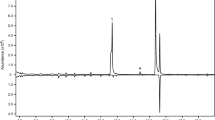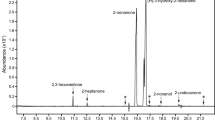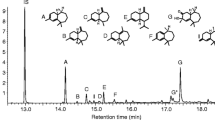Abstract
The leaf beetle Diorhabda elongata Brullé (Coleoptera: Chrysomelidae)has been introduced as a biological control agent for saltcedars, Tamarix spp., an exotic, invasive weedy tree in the western United State. Gas chromatographic (GC) analysis of volatiles collected from feeding male or female beetles, or saltcedar foliage alone, showed two components produced almost exclusively by males. These compounds elicited responses from antennae of male and female beetles in GC-electroantennographic detection (EAD) analyses. The compounds were identified as (2E,4Z)-2,4-heptadienal (1) and (2E,4Z)-2,4- heptadien-1-ol (2) by GC-mass spectrometry (MS), and confirmed with authentic standards. The two compounds were also detected at trace levels from feeding females and foliage controls, but the amounts from feeding males were 8-40 times higher, typically 55-125 ng per day per male. The amounts of 1 and 2 in collections from females did not differ significantly from amounts collected from control foliage. In field trials, 2 as a single component was as attractive as a 1:1 blend of 1 and 2. Compound 1 as a single component was more attractive than controls, but much less attractive than 2 or the blend. Males and femaleswere attracted in about equal numbers, indicating that this is an aggregation pheromone.
Similar content being viewed by others
Explore related subjects
Discover the latest articles and news from researchers in related subjects, suggested using machine learning.References
ANALYTICAL SOFTWARE. 1998. Statistix for Windows User’s Manual. Analytical Software, Tallahassee, Florida.
ARNETT, R. H. 1993. American Insects: A Handbook of the Insects ofAmerica North of Mexico. Sandhill Crane Press, Gainesville, Florida.
BARTELT, R. J., COSSé, A. A., ZILKOWSKI, B. W., WEISLEDER, D., andMOMANY, F. A. 2001. Male-specific sesquiterpenes from Phyllotreta and Aphthona flea beetles. J. Chem. Ecol. 27:2397–2423.
COSSé, A. A. and BARTELT, R. J. 2000. Male-produced aggregationpheromone of Colopterus truncatus: structure, electrophysiological andbehavioral activity. J. Chem. Ecol. 26:1735–1748.
COSSé, A. A., BARTELT, R. J., andZILKOWSKI, B. W. 2002.Identification and electrophysiological activity of a novel hydroxy ketoneemitted by male cereal leaf beetles. J. Nat. Prod. 65:1156–1160.
DELOACH, C. J. 1989. Prospects for biological control of saltcedar(Tamarix spp.) in riparian habitats of the southwestern United States. pp. 307–314, in E. S. Delfosse (ed). Proc. 7th Int. Symp. Biol Control Weeds, Rome, Italy, 1988, Instituto Sperimentale per la Patologia Vegetale, MAF, Rome.
DELOACH, C. J., CARRUTHERS, R. I., LOVICH, J., and DUDLEY, T. L. 2000. Ecological interactions in the biological control of saltcedar (Tamarixspp.) in the U.S.: toward a new understanding. pp. 819–874 in: N. R.Spencer (ed.), Proc. X Int. Symp. Biol. Control, Bozeman, MT, July 1999.
DELOACH, C. J., LEWIS, P. A., CARRUTHERS, R. I., HERR, J. C., TRACY, J.L., and JOHNSON, J. 2003. Host specificity of a leaf beetle, Diorhabdaelongata deserticola (Coleoptera: Chrysomelidae) from Asia, for biologicalcontrol of saltcedars (Tamarix: Tamaricaceae) in the western United States.Biol. Control 27:117–147.
DELOACH, C. J., CARRUTHERS, R., DUDLEY, T., EBERTS, D., KAZMER, D., KNUTSON, A., BEAN, D., KNIGHT, J., LEWIS, P., TRACY, J., HERR, J., ABBOT, G., PRESTWICH, S., ADAMS, G., MITYAEV, I., JASHENKO, R., LI, B., SOBHIAN, R., KIRK, A., ROBBINS, T., and DELFOSSE, E. 2004. First results for controlof saltcedar (Tamarix spp.) in the open field in the western United States.11th Int. Symp. Biol. Control Weeds, Canberra, Australia.
DICKENS, J. C., OLIVER, J. E., HOLLISTER, B., DAVIS, J. C., and KLUN, J. A. 2002. Breaking a paradigm: Male-produced aggregation pheromone for theColorado potato beetle. J. Exp. Biol. 205:1925–1933.
EPHRUSSI, B. and BEADLE, G. W. 1936. A technique of transplantation forDrosophila. Am. Nat. 70:218–225.
FRANKEL, E. R. 1998. Lipid Oxidation. The Oily Press LTD., Dundee, Scotland.
GUSS, P. L., TUMLINSON, J. H., SONNET, P. E., and PROVEAUX, A. T. 1982.Identification of a female-produced sex pheromone of the western cornrootworm Diabrotica virgifera virgifera. J. Chem. Ecol. 8:545–556.
HEATH, R. R. and SONNET, P. E. 1980. Technique for in situ coating ofAg+ onto silica gel in HPLC columns for the separation of geometricalisomers. J. Liq. Chromatogr. 3:1129–1135.
KRYSAN, J. L., MCDONALD, I. C., and TUMLINSON, J. H. 1989. Phenogrambased on allozymes and its relationship to classical biosystematics andpheromone structure among eleven Diabroticites (Coleoptera: Chrysomelidae).Ann. Entomol. Soc. Amer. 82:574–581.
LEWIS, P. A., DELOACH, C. J., KNUTSON, A. E., and TRACY, J. L. 2003. Biology of Diorhabda elongata deserticola (Coleoptera: Chrysomelidae), anAsian leaf beetle for biological control of saltcedars (Tamarix spp.) in theUnited States. Biol. Control 27:101–116.
METCALF, R. L. and METCALF, E. R. 1992. Plant Kairomones in InsectEcology and Control. Chapman and Hall, New York, 168 pp.
PETROSKI, R. J. 2003. Straightforward preparation of(2E,4Z)-2,4-heptadien-1-ol and (2E,4Z)-2,4-heptadienal. Synth. Comm. 33:3233–3241.
PIVNICK, K. A., LAMB, R. J., and REED, D. 1992. Response of fleabeetles, Phyllotreta spp., to mustard oils and nitriles in field trappingexperiments. J. Chem. Ecol. 18:863–873.
RAO, S., COSSé, A. A., ZILKOWSKI, B. W., and BARTELT, R. J. 2003.Aggregation pheromone of the cereal leaf beetle: field evaluation andemission from males in the laboratory. J. Chem. Ecol. 29:2165–2175.
VISSER, J. H. and AVé, D. A. 1978. General green leaf volatiles inthe olfactory orientation of Colorado beetle, Leptinotarsa decemlineata.Entomol. Exp. Appl. 24:538–549.
WILEY SPECTRAL LIBRARY,6TH ED. 1995. CD-ROM. John Wiley and Sons, Inc.
WILLIAMS, M. A. and FLEMING, I. 1980. Spectroscopic Methods in OrganicChemistry, 3rd ed. McGraw-Hill, Londen.
ZAVALETA, E. 2000. The economic value of controlling an invasive shrub.Ambio 29:462–467.
Author information
Authors and Affiliations
Corresponding author
Additional information
Mention of trade names or commercial products in this article is solely for the purpose of providing specific information and does not imply recommendation or endorsement by the U.S. Department of Agriculture.
Rights and permissions
About this article
Cite this article
Coss, A.A., Bartelt, R.J., Zilkowski, B.W. et al. The aggregation pheromone of Diorhabda elongata, a biological control agent of saltcedar(Tamarix spp.): identification of two behaviorally active components. J Chem Ecol 31, 657–670 (2005). https://doi.org/10.1007/s10886-005-2053-2
Received:
Revised:
Accepted:
Issue Date:
DOI: https://doi.org/10.1007/s10886-005-2053-2




